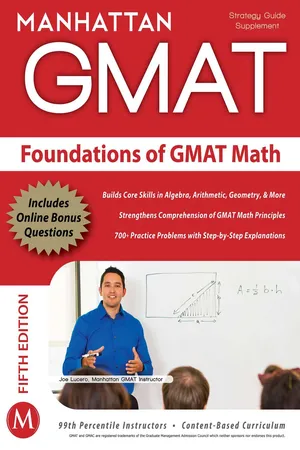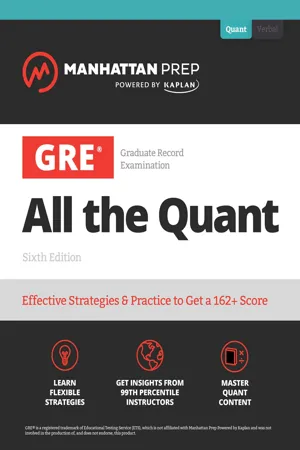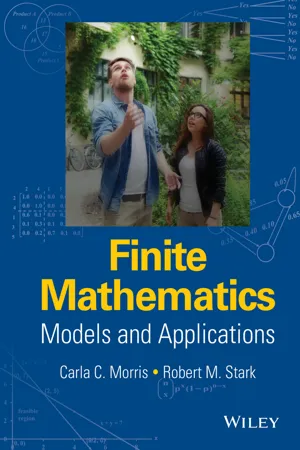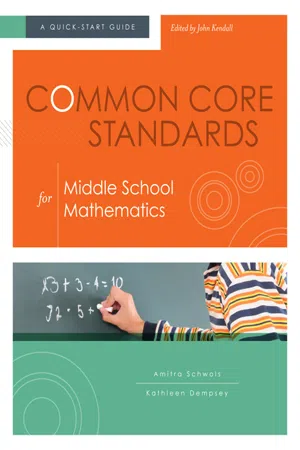Mathematics
Powers and Exponents
Powers and exponents in mathematics refer to the shorthand notation for repeated multiplication. A power is represented as a base number raised to an exponent, indicating the number of times the base is multiplied by itself. Exponents can be used to simplify and solve complex mathematical expressions, making calculations more efficient and manageable.
Written by Perlego with AI-assistance
Related key terms
Related key terms
1 of 4
Related key terms
1 of 3
7 Key excerpts on "Powers and Exponents"
- eBook - ePub
- Manhattan GMAT(Author)
- 2011(Publication Date)
- Manhattan Prep Publishing(Publisher)
Chapter 3: Exponents & RootsIn This Chapter:• Rules of exponents • Rules of roots Basics of ExponentsTo review, exponents represent repeated multiplication. The exponent, or power, tells you how many bases to multiply together.53 = 5 × 5 × 5 = 125 Five cubed equals three fives multiplied together, or five times five times five, which equals one hundred twenty-five. An exponential expression or term simply has an exponent in it. Exponential expressions can contain variables as well. The variable can be the base, the exponent, or even both.a4 = a × a × a × a a to thefourth equals four a's multipliedtogether, or a times atimes a times a.
Any base to the first power is just that base.3 x= 3 × 3 ×…× 3 Three to thexth power equals three times three timesdot dot dot times three.There are x three's in theproduct, whatever x is.
Memorize the following powers of positive integers.71 = 7 Seven to the first equals seven. Squares Cubes 12 = 122 = 432 = 942 = 1652 = 2562 = 3672 = 4982 = 6492 = 81102 = 100112 = 121122 = 144132 = 169142 = 196152 = 225202 = 400302 = 900 13 = 123 = 833 = 2743 = 6453 = 125103 = 1,000 Powers of 2 21 = 222 = 423 = 824 = 1625 = 3226 = 6427 = 12828 = 25629 = 512210 = 1,024 Powers of 3 31 = 332 = 933 = 2734 = 81 Powers of 4 41 = 442 = 1643 = 64
Remember PEMDAS? Exponents come before everything else, except Parentheses. That includes negative signs.Powers of 5 51 = 552 = 2553 = 125 Powers of 10 101 = 10102 = 100103 = 1,000 –32 = –(32 ) = –9 The negative of three squared equals the negative of the quantity three squared, which equals negative nine. To calculate –32 , square the 3 before you multiply by negative one (–1). If you want to square the negative sign, throw parentheses around –3.(–3)2 = 9 The square ofnegative three equals nine. In (–3)2 , the negative sign and the three are both inside the parentheses, so they both get squared. If you say “negative three squared,” you probably mean (–3)2 , but someone listening might write down –32 - eBook - ePub
GRE All the Quant
Effective Strategies & Practice from 99th Percentile Instructors
- (Author)
- 2023(Publication Date)
- Manhattan Prep(Publisher)
CHAPTER 5 Exponents and RootsSo far, exponents have been defined as a shorthand way of expressing multiplication. For example, 52 = 5 × 5 = 25 and because 92 = 81. For larger numbers, however, this approach could be prohibitively time consuming, and it’s all but impossible when you have variables. In this chapter, you’ll learn all of the exponent and root rules that will allow you to combine exponential terms and simplify complex expressions.Exponents and Roots Language
Have you ever heard the expression, “Wow, that increased exponentially!”? This expression captures the essence of exponents. When a number greater than 1 increases exponentially, it does not merely increase; it increases a significant amount and it does so very rapidly.In fact, the greater the exponent, the faster the rate of increase. Consider the following progression:This trend holds true when positive bases greater than 1 are raised to higher and higher powers. With many other numbers, though, this trend will not necessarily hold true. For example, when the number 1 is raised to any exponent, it does not increase at all; it remains 1.The expression 43 consists of a base (4) and an exponent (3). This expression is read as “four to the third power” or “four cubed” and means four multiplied by itself three times. Thus, four cubed is 43 = 4 × 4 × 4 = 64.Roots undo exponents. Asking for the cube root of 64 is the same thing as asking “What number, when cubed, gives 64?” Thus, . Four cubed is 64, and 64 cube rooted is 4.Most exponents will be expressed as “the base (raised) to the power of the exponent.” So 35 is called “three to the fifth power” (and equals 243, incidentally). To undo that, you would take the fifth root of 243, which is written as and which equals 3.Something raised to the second power is called a square, and something raised to the third power is a cube. After that, use the number of the power (fourth power, fifth power, sixth power). For second and third powers, the GRE may use either the special names (square, cube) or the more traditional ones. - eBook - ePub
The Parallel Curriculum in the Classroom, Book 2
Units for Application Across the Content Areas, K-12
- Carol Ann Tomlinson, Sandra N. Kaplan, Jeanne H. Purcell, Jann H. Leppien, Deborah E. Burns, Cindy A. Strickland(Authors)
- 2005(Publication Date)
- Corwin(Publisher)
6The Power of Exponents
A Middle or High School Math UnitIncorporating All Four Parallels Kristen Wogman BaronBACKGROUND FOR UNIT
The topic of exponents and exponential functions is an important part of any Algebra I course. Students need to be able to multiply and divide exponential expressions, use scientific notation, and solve and graph simple exponential functions. This unit puts these initial concepts into a context to which students can relate and for which they can see a purpose.Students act as mathematicians in this unit as they discover the rules of exponents and the common characteristics of exponential function graphs. They also learn to use graphing calculator technology as a tool to aid them in computations. They act as scientists as they explore scientific notation of large and small numbers in the context of astronomy and microbiology. They act as financial planners as they learn to invest money for maximum profit.There are several options for assessment at the end of the unit. These options relate to the different fields of study we cover in the unit. Students choose an assessment based on their interest in a field area. This allows them to work in areas of interest to share their knowledge of the subject. - eBook - ePub
- Lisa Healey(Author)
- 2021(Publication Date)
- Chemeketa Press(Publisher)
6 = 15625.Notice that b1 stands for one factor of b, so b1 = b. We typically don’t write the exponent in this case. Two other powers have specific names. We refer to b2 as “b squared” and b3 as “b cubed.” These nicknames come from geometry formulas for the area of a square and the volume of a cube.Figure 1. Calculating powers on the calculator.It’s common to confuse the two expressions −34 and (−3)4 . The first expression indicates that we should raise 3 to the 4th power and then find its opposite.While the second expression indicates that we should raise −3 to the 4th power.We can use a calculator to check both computations, as you see in Figure 2 .Figure 2. Compute −34 and (−3)4 .B. Properties of Exponents
The Product Property of Exponents
Consider the product x3 · x4 . Both terms have the same base, x, but they are raised to different exponents. We expand each expression, and then rewrite the resulting expression.The result is that x3 · x4 equals x3+4 , which equals x7 .Notice that the exponent of the product is the sum of the exponents of the factors. In other words, when multiplying exponential expressions with the same base, we write the result with the common base and add the exponents. This is the product property of exponents and can be stated in general terms asThe Quotient Property of Exponents
In a similar way to the product property, we can simplify an expression such as , where m > n. Consider the example . Perform the division by canceling common factors.Notice that the exponent of the quotient is the difference between the exponents of the divisor and dividend. So the shortcut would look like this:In other words, when dividing exponential expressions with the same base, we write the result with the common base and subtract the exponents. This is the quotient property of exponents, which can be stated in general terms as - eBook - ePub
- Toby Wagner(Author)
- 2021(Publication Date)
- Chemeketa Press(Publisher)
4.4 Power Rules of Exponents
Overview
We know how to simplify a product of powers, a quotient of powers, and even something to the power of zero. Now, it’s time to explore what happens when we take the power of a power. Here’s a related problem:Simplify: (7 a4 b2 c8 )2This problem contains an expression involving powers contained within parentheses, and then an exponent outside of the parentheses. We haven’t seen anything like this yet. We need to learn how to simplify the power of a power before we are ready to tackle this problem.As you read through this section, you will learn how to: ◆ Use the power rule for powers ◆ Use the power rule for products ◆ Use the power rule for quotientsA. The Power Rule for Powers
Now that we can use the product and quotient rules for exponents to multiply and divide exponential expressions with the same base, it’s time to explore situations in which we raise an exponential expression to a power. Some people think of this as putting two exponents on the same base. When we do this, parentheses keep the exponents separated.Example 1 illustrates the following rule.Example 1Simplify the following expressions.1.(a2 )32.(x9 )4SolutionsLook at the exponents on the beginning and the simplified expressions. Notice that 2 · 3 = 6.1.(a2 )3Again, look at the exponents on the beginning and the simplified expressions: 9 · 4 = 36.2.(x9 )4The Power Rule for PowersIn other words, if we raise a power to a power, then we multiply the exponents. Let’s look at more expressions involving the power rule for powers.If A is a real number, and if m and n are natural numbers, then (Am ) = Am n .Practice AExample 2Simplify the following expressions.1.(x3 )42.(d20 )63.Solutions1.(x3 )4(x3 )4 = x3 · 4= x12Multiplying exponents can often be done mentally, leaving just one step of writing.Simplify these two expressions using the power rule for powers. Then check your work.1.(x5 )42.(y7 )7 - eBook - ePub
Finite Mathematics
Models and Applications
- Carla C. Morris, Robert M. Stark(Authors)
- 2015(Publication Date)
- Wiley(Publisher)
Their distinguishing feature is that the variable, x, is an exponent. The base, b, is any positive real valued number (other than 1). The rates of change of exponential functions are greater than those for polynomial functions. Recall the Laws of Exponents (see the following text)! Laws of Exponents 1. 5. 2. 6. 3. 7. 4. 8. Example 1.5.1 Using Laws of Exponents Simplify these expressions using Laws of Exponents a. b. c. d. Solution: a. Since the same base appears twice within the parenthesis, add the exponents to yield. Next, multiply the exponents to yield. b. There is a common base of 3, as 9 and 27 are powers of 3. Therefore,. c. First add the numerator exponents to yield. Next, subtract the exponents to simplify the expression to. d. Since the exponents are the same, the expression can be rewritten as. Often, when solving exponential equations, one either tries to equate bases or exponents. If there is a common base, exponents can be equated. Likewise, if the exponents are equal, their bases can be equated. The additional laws that follow are useful for solving exponential equations. Additional Laws of Exponents If then. If then. Example 1.5.2 Simplifying Exponential Equations Solve for x in the following: (a) Solution: a. Because the variable is an exponent, first equate bases. Rewriting the equation as or yields or. b. Rewriting the equation as yields or. c. First, rewrite as. Therefore, and. d. Here, we seek to equate exponents. The equation is rewritten as, which yields. Graphs of exponential functions have several properties of interest. Their domain is the real numbers, while their range is the positive real numbers. There is no x -intercept and the y -intercept is at. There is a horizontal asymptote at (the x -axis). When the base is between 0 and 1 the function is decreasing, and when the base exceeds 1, the function is increasing - eBook - ePub
Common Core Standards for Middle School Mathematics
A Quick-Start Guide
- Amitra Schwols, Kathleen Dempsey, John Kendall(Authors)
- 2013(Publication Date)
- ASCD(Publisher)
4. Perform operations with numbers expressed in scientific notation, including problems where both decimal and scientific notation are used. Use scientific notation and choose units of appropriate size for measurements of very large or very small quantities (e.g., use millimeters per year for seafloor spreading). Interpret scientific notation that has been generated by technology.In 5th grade, students are introduced to exponents as they begin to explore the place value system and understand how to denote powers of 10 (5.NBT.A.2). They extend this understanding in 6th grade as they begin to write and evaluate numerical expressions involving exponents and use the order of operations on expressions including exponents (6.EE.A.1–2 ). In 8th grade, Standards 1, 2, 3, and 4 (8.EE.A.1–4) introduce students to integer exponents and equations involving exponents. The understanding they gain here will assist them in their high school work with rational exponents (HSN-RN.A.1–2).Understand the connections between proportional relationships, lines, and linear equations
The second cluster in this domain (see Figure 4.9) explicitly connects the idea of proportional relationships to lines and linear equations.Figure 4.9 | Understand the Connections Between Proportional Relationships, Lines, and Linear Equations (8.EE.B)
5. Graph proportional relationships, interpreting the unit rate as the slope of the graph. Compare two different proportional relationships represented in different ways. For example, compare a distance–time graph to a distance–time equation to determine which of two moving objects has greater speed.6. Use similar triangles to explain why the slope m is the same between any two distinct points on a non-vertical line in the coordinate plane; derive the equation y = mx
Index pages curate the most relevant extracts from our library of academic textbooks. They’ve been created using an in-house natural language model (NLM), each adding context and meaning to key research topics.
Explore more topic indexes
Explore more topic indexes
1 of 6
Explore more topic indexes
1 of 4






